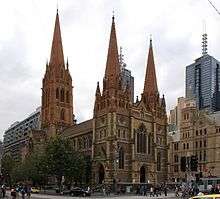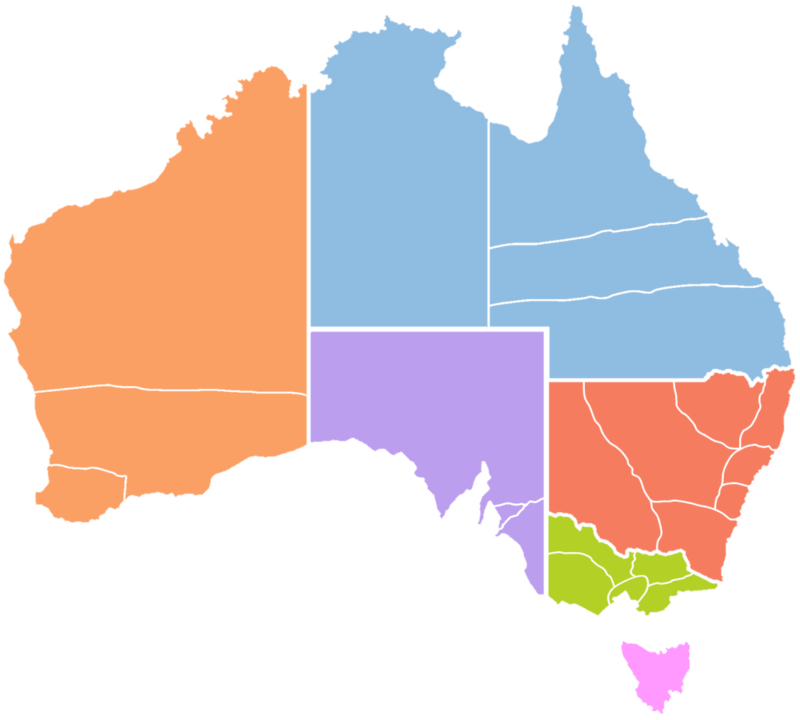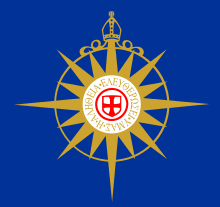Anglican Church of Australia
| Anglican Church of Australia | |
|---|---|
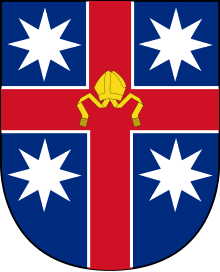 Arms
| |
| Independence | 1962 |
| Primate |
Philip Freier Archbishop of Melbourne[1] |
| Polity | Episcopal |
| Territory | Australia |
| Members | 3.1 million |
| Website | anglican.org.au |
The Anglican Church of Australia is a Christian church in Australia and an autonomous province of the Anglican Communion. It is the second largest church in Australia, after the Roman Catholic Church.[2] According to the 2016 census, 3.1 million Australians identify as Anglicans.[3] For much of Australian history, the Church of England (now known as the Anglican Church of Australia) was the largest religious denomination.
History
When the First Fleet was sent to New South Wales in 1787, Richard Johnson of the Church of England was licensed as chaplain to the fleet and the settlement. In 1825 Thomas Scott was appointed Archdeacon of Australia under the jurisdiction of the Bishop of Calcutta. William Grant Broughton, who succeeded Scott in 1829, was consecrated the first (and only) "Bishop of Australia" in 1836.

In early Colonial times, the Church of England clergy worked closely with the governors. Richard Johnson, a chaplain, was charged by the governor, Arthur Phillip, with improving "public morality" in the colony, but he was also heavily involved in health and education.[4] Samuel Marsden (1765–1838) had magisterial duties, and so was equated with the authorities by the convicts. He became known as the "flogging parson" for the severity of his punishments.[5] Some of the Irish convicts had been transported to Australia for political crimes or social rebellion in Ireland, so the authorities were suspicious of Roman Catholicism for the first three decades of settlement and Roman Catholic convicts were compelled to attend Church of England services and their children and orphans were raised by the authorities as Anglicans.[6][7]
The Church of England lost its legal privileges in the Colony of New South Wales by the Church Act of 1836. Drafted by the reformist attorney-general John Plunkett, the act established legal equality for Anglicans, Roman Catholics and Presbyterians and was later extended to Methodists.[8]
A mission to the Aborigines was established in the Wellington Valley in New South Wales by the Church Missionary Society in 1832, but it ended in failure and indigenous people in the 19th century demonstrated a reluctance to convert to the religion of the colonists who were seizing their lands.[9]
In 1842 the Diocese of Tasmania was created. In 1847 the rest of the Diocese of Australia was divided into the four separate dioceses of Sydney, Adelaide, Newcastle and Melbourne. Over the following 80 years the number of dioceses increased to 25.
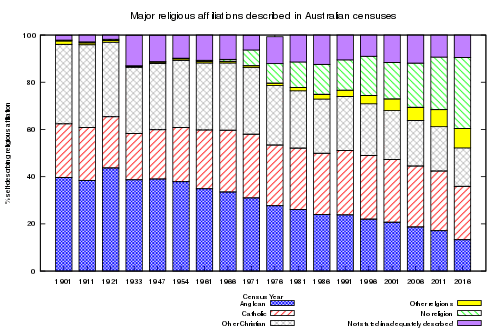
Sectarianism in Australia tended to reflect the political inheritance of Britain and Ireland. Until 1945, the vast majority of Roman Catholics in Australia were of Irish descent, causing the Anglo-Protestant majority to question their loyalty to the British Empire.[7] The Australian Constitution of 1901 provided for freedom of religion. Australian society was predominantly Anglo-Celtic, with 40% of the population being Anglican. It remained the largest Christian denomination until the 1986 census. After World War II, the ethnic and cultural mix of Australia diversified and Anglicanism gave way to Roman Catholicism as the largest denomination. The number of Anglicans attending regular worship began to decline in 1959 and figures for occasional services (baptisms, confirmations, weddings and funerals) started to decline after 1966.[9] In recent times, the Anglican and other Christian churches of Australia have been active in ecumenical activity. The Australian Committee for the World Council of Churches was established in 1946 by the Anglican and mainline Protestant churches. The movement evolved and expanded with Eastern and Oriental Orthodox churches later joining and by 1994 the Roman Catholic Church was also a member of the national ecumenical body, the National Council of Churches in Australia.
Since 1 January 1962 the Australian church has been autocephalous and headed by its own primate. On 24 August 1981 the church officially changed its name from the Church of England in Australia to the Anglican Church of Australia.[11]
Although the Book of Common Prayer remains the official standard for Anglican belief and worship in Australia, An Australian Prayer Book (AAPB) was published in 1978 after a prolonged revision of liturgy. Another alternative service book, A Prayer Book for Australia (APBA), was published in 1995.[9]
In 1985 the general synod of the Australian church passed a canon to allow the ordination of women as deacons. In 1992 the general synod approved legislation allowing dioceses to ordain women to the priesthood. Dioceses could choose to adopt the legislation. In 1992, 90 women were ordained in the Anglican Church of Australia and two others who had been ordained overseas were recognised.[12] After decades of debate the issue of women's ordination, particularly as bishops, continues to divide traditionalists and reformers within the church. As of November 2013 five dioceses had not ordained women as priests and two had not ordained women as deacons.[13][14][15] The most recent diocese to vote in favour of ordaining women as priests was the Ballarat diocese in October 2013.[15] In 2008, Kay Goldsworthy was ordained as an assistant bishop for the Diocese of Perth, thus becoming the first woman consecrated as a bishop of the Anglican Church of Australia.[16] Sarah Macneil was elected in 2013 to be the first female diocesan bishop in Australia.[17] In 2014 she was consecrated and installed as the first female diocesan bishop in Australia (for the Diocese of Grafton in New South Wales).[18]
The church remains a major provider of education and welfare services in Australia.[19] It provides chaplains to the Australian Defence Force, hospitals, schools, industry and prisons.[9] Senior clergy such as Peter Jensen, former Archbishop of Sydney, have a high profile in discussions on a diverse range of social issues in contemporary national debates.[20] In recent times the church has encouraged its leaders to talk on such issues as indigenous rights; international security; peace and justice; and poverty and equity.[21] The current primate is Philip Freier, Archbishop of Melbourne, who took office on 4 July 2014.[1]
Like other religious groups, the church has come under criticism in light of cases of sexual abuse by clergy and others.[22][23]
Demographics and structure
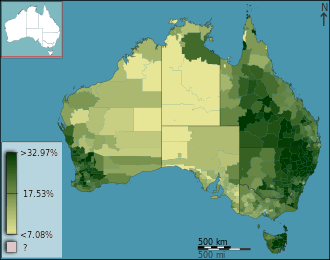
Until the 1986 census, Australia's most populous Christian church was the Anglican Church of Australia. Since then Roman Catholics have outnumbered Anglicans by an increasing margin. One rationale to explain this relates to changes in Australia's immigration patterns. Prior to the Second World War, the majority of immigrants to Australia had come from the United Kingdom – though most of Australia's Roman Catholic immigrants had come from Ireland. After World War II, Australia's immigration program diversified and more than 6.5 million migrants arrived in Australia in the 60 years after the war, including more than a million Roman Catholics.
Census data shows that as a percentage of population Anglican affiliation peaked in 1921 at 43.7%, and the number of persons indicating Anglican affiliation peaked in 1991 at 4 million. In the 2011 there were 3,679,907 Anglicans, representing 17.1 per cent of the population. (See accompanying graph.)
The Australian church consists of twenty-three dioceses arranged into five provinces (except for Tasmania) with the metropolitical sees in the states' capital cities. Broughton Publishing is the church's national publishing arm.[24]
| State/Territory[25] | % 2016 | % 2011 | % 2006 | % 2001 |
|---|---|---|---|---|
| Australian Capital Territory | 10.8 | 14.7 | 16.7 | 18.5 |
| New South Wales | 15.5 | 19.9 | 21.8 | 23.8 |
| Northern Territory | 8.4 | 11.4 | 12.3 | 14.7 |
| Queensland | 15.3 | 18.9 | 20.4 | 22.5 |
| South Australia | 10.0 | 12.6 | 13.7 | 15.2 |
| Tasmania | 20.4 | 26.0 | 29.3 | 32.4 |
| Total | 13.3 | 17.1 | 18.7 | 20.7 |
| Victoria | 9.0 | 12.3 | 13.6 | 15.3 |
| Western Australia | 14.3 | 18.8 | 20.4 | 22.6 |
Indigenous ministry
The National Aboriginal and Torres Strait Islander Anglican Council (NATSIAC) appoints two Indigenous bishops for national work with indigenous people: the National Aboriginal Bishop is based in South Australia (as an assistant bishop of the Anglican Diocese of Adelaide); while the National Torres Strait Islander Bishop is based at Thursday Island, Queensland (as an assistant bishop of the Anglican Diocese of North Queensland).
Society, arts and culture
Welfare and education
Anglicans have played a prominent role in welfare and education since Colonial times, when First Fleet chaplain Richard Johnson was credited by one convict as "the physician both of soul and body" during the famine of 1790 and was charged with general supervision of schools.[4] Today the church remains a significant provider of social welfare with organisations working in education, health, missionary work, social welfare and communications. Welfare organisations include Anglicare and Samaritans. There are around 145 Anglican schools in Australia, providing for more than 105,000 children.[19] Church schools range from low-fee, regional and special needs schools to high-fee leading independent schools like Geelong Grammar, whose alumni include Prince Charles and Rupert Murdoch; and Sydney's The Kings School. The Australian Anglican Schools Network is the national schools network of the Australian General Synod.[26]
Architecture
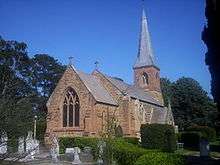
The first Church of England edifice was built in the colony of New South Wales in 1793.[27] Today, most towns in Australia have at least one Christian church. One of Australia's oldest Anglican churches is St James' Church in Sydney, built between 1819 and 1824. The historic church was designed by Governor Macquarie's architect, Francis Greenway – a former convict – and built with convict labour. The church is set on a sandstone base and built of face brick with the walls articulated by brick piers.[28] Sydney's Anglican cathedral, St Andrew's, was consecrated in 1868 from foundations laid in the 1830s. Largely designed by Edmund Thomas Blacket in the Perpendicular Gothic style reminiscent of English cathedrals. Blacket also designed St Saviour's Cathedral in Goulburn, based on the Decorated Gothic style of a large English parish church and built between 1874 and 1884.[29]
St Paul's Cathedral, Melbourne, from a foundation stone laid in 1880, is a Melbourne landmark. It was designed by the distinguished English architect William Butterfield in Gothic Transitional.[30]
Tasmania is home to a number of significant colonial Anglican buildings including those located at Australia's best preserved convict era settlement, Port Arthur. According to 19th century notions of prisoner reform, the Model Prison incorporates a grim chapel, into which prisoners in solitary confinement were shepherded to listen (in individual enclosures) to the preacher's Sunday sermon – their only permitted interaction with another human being.[31] Adelaide, the capital of South Australia has long been known as the City of Churches and its St Peter's Anglican Cathedral is a noted city landmark.[32]
The oldest building in the city of Canberra is the picturesque St John the Baptist Church in Reid, consecrated in 1845. This church long predates the city of Canberra and is not so much representative of urban design as it is of the Bush chapels which dot the Australian landscape and stretch even into the far Outback.
A number of notable Victorian era chapels and edifices were also constructed at church schools across Australia. Along with community attitudes to religion, church architecture changed significantly during the 20th century.
Ordination of women
The church permits the ordination of women on a diocesan basis. In 1992, the church ordained the first women priests.[33] In 2008, the Diocese of Perth consecrated the first woman bishop, the Rt Revd Kay Goldsworthy.[34] Then, in 2014, the Diocese of Grafton consecrated and installed its first diocesan woman bishop, the Rt Revd Sarah Macneil. Bishop Kay Goldsworthy also became the second diocesan woman bishop when she was enthroned as bishop of Gippsland.[35] The dioceses of Sydney, North West Australia and The Murray do not ordain women as priests.[36] In 2017, the Diocese of The Murray ordained the first woman as a deacon becoming the last diocese to ordain women to the diaconate.[37]
In August 2017, the Anglicans of Western Australia elected the Anglican Church of Australia's first female archbishop, Kay Goldsworthy.[38] In a statement representing a conservative and complementation view, Bishop Gary Nelson said that Archbishop Goldsworthy "would not be recognised in her new role" as the metropolitan for the province.[39]
Same-sex unions and LGBT clergy
In the Seventeenth Session of the General Synod of the Anglican Church of Australia in 2017, the Anglican Church passed a motion recognising "that the doctrine of our church, in line with traditional Christian teaching, is that marriage is an exclusive and lifelong union of a man and a woman, and further, recognises that this has been the subject of several General Synod resolutions over the past fifteen years".[40] In 2018, the Primate of Australia and Archbishop of Melbourne, Philip Freier, released an ad clerum re-iterating the current position that clergy cannot perform a same-sex marriage, but priests can attend, participate in procession, offer prayer, and preside over the Eucharist at a same-sex wedding.[41][42] At the same time, the church does not have an official stance on homosexuality itself.[43]
During a meeting, the House of Bishops stated that they "accept the weight of 1998 Lambeth Resolution 1.10 and the 2004 General Synod resolutions 33, 59 and 61–64 as expressing the mind of this church on issues of human sexuality ... and understand that issues of sexuality are subject to ongoing conversation". A former primate, Peter Carnley, supported the blessing of same-sex relationships and supported "recognition of lifelong friendships between two homosexuals which would give them the same legal status as a heterosexual married couple."[44][45] A spokesman for Phillip Aspinall, an archbishop, stated that "In effect it is an undertaking not to ordain, license, authorise or appoint persons whom the bishop knows to be in a sexual relationship outside of marriage."[46] At the same time, Archbishop Aspinall stated that he personally does not take an official position.[47] Despite what the spokesman said, however, an Anglican priest came out as gay in 2005 in Melbourne.[48] In the Diocese of Perth, "there are gay and lesbian clergy serving in the priesthood."[49] Archbishop Roger Herft, as a diocesan bishop, "support[ed] blessing gay unions."[50] In 2012, a bishop "appoint[ed] a gay priest in a same-sex partnership to a Gippsland parish."[51] The Anglican Diocese of Sydney, the largest of the country, has expressed its opposition to same-sex unions and has been involved in the Anglican realignment as a member of the Fellowship of Confessing Anglicans.[52]
However, many clergy and bishops in the church support same-sex unions. The Diocese of Wangaratta has voted to support the blessing of same-sex civil unions.[53] In 2012, the Diocese of Gippsland appointed an openly partnered gay priest.[54][55] In 2013, the Diocese of Perth voted in favour of recognising same-sex unions.[56] Archbishop Roger Herft vetoed the Perth motion, but said "what we have in the Diocese [of Perth] of course is a number of people in same-sex relationships amongst the clergy and amongst the laity and we have always said that people of all forms of sexuality and orientation are welcome...."[57] In 2015, the Bishop of Wangaratta endorsed same-sex marriage legislation, and clergy offered to perform gay marriages when allowed to do so.[58][59] In Grafton, Bishop Sarah Macneil has taken an affirming stance.[60] Bishop Greg Thompson of Newcastle had taken a stance in favour of gay rights.[61]
In 2015, an arm of the Anglican Church in Southern Queensland voted in favour of same-sex civil unions.[62][63] Also, Bishop Kay Goldsworthy appointed an openly gay and partnered priest to another post.[64] In response, the Sydney Synod passed a resolution stating that Sydney "views the actions of the Bishop of Gippsland as a breach of collegiality and fellowship at a profound level..."[65] In 2016, the Bishop of Ballarat declared his support for same-sex marriage.[66] In April 2016, a parish in the Diocese of Perth blessed the union of a same-sex couple.[67] At General Synod in 2017, the Synod passed a resolution criticising the Scottish Episcopal Church for its acceptance of same-sex marriage as well as an additional resolution calling for the Church of Australia "to have a series of conversations on its understanding of sexuality."[68] Also in 2017, Western Australia elected Bishop Kay Goldsworthy to be archbishop; Goldsworthy shared that she supports an "inclusive" approach to same-sex marriage.[69] "Archbishop Goldsworthy revealed that she had voted Yes in the same-sex marriage survey."[39]
Regarding transgender issues, there are dioceses and congregations with serving transgender clergy. In 2017, Archbishop Phillip Aspinall asked for "prayerful support" for the Revd Josephine (Jo) Inkpin who had transitioned and "come out" as a transgender woman.[70] "The Archbishop of Brisbane Dr Phillip Aspinall supported Dr Inkpin and passed on her statement to clergy in July 2017, along with his wish that 'unhelpful speculation' might be avoided."[71] The Revd Jo Inkpin continues to serve in the Anglican Church Southern Queensland.[72] She shared that the bishops and leaders of the Diocese of Brisbane "have assisted in arrangements for enabling [her] public recognition of gender." Inkpin, who is married to the Revd Penny Jones, one of the first female priests ordained in Australia, is the first openly transgender priest in Australia.[73]
Provinces and dioceses
The whole church is led by the elected primate, Philip Freier, Archbishop of Melbourne. The provinces and dioceses are listed with each diocese's bishop or archbishop:
- Province of Victoria (Metropolitan: Philip Freier, Archbishop of Melbourne)
- Gippsland (vacant)
- Wangaratta (John Parkes)
- Melbourne (Archbishop: Philip Freier)
- Bendigo (Matthew Brain)
- Ballarat (Garry Weatherill)
- Province of South Australia (Metropolitan: Geoffrey Smith, Archbishop of Adelaide)
- The Murray (John Ford)
- Adelaide (Archbishop: Geoffrey Smith)
- Willochra (John Stead)
- Province of New South Wales (Metropolitan: Glenn Davies, Archbishop of Sydney)
- Sydney (Archbishop: Glenn Davies)
- Canberra and Goulburn (vacant)
- Riverina (Rob Gillion)
- Bathurst (Ian Palmer)
- Newcastle (Greg Thompson)[74]
- Armidale (Rick Lewers)
- Grafton (elect Murray Harvey)
- Province of Queensland (Metropolitan: Phillip Aspinall, Archbishop of Brisbane)
- Brisbane (Archbishop: Phillip Aspinall)
- Rockhampton (David Robinson)
- North Queensland (Bill Ray)
- Northern Territory (Greg Anderson)
- Province of Western Australia (Metropolitan: Kay Goldsworthy, Archbishop of Perth)
- North West Australia (Gary Nelson)
- Perth (Archbishop: Kay Goldsworthy)
- Bunbury (elect Ian Coutts)
- Extraprovincial diocese
Map of dioceses
| KEY to province colours | New South Wales | Victoria | Queensland | Western Australia | South Australia | Extraprovincial |
Ecumenical relations
The church is a member of the Christian Conference of Asia.
Relation with the Anglican realignment
The Anglican Diocese of Sydney has been a leading name in the Anglican realignment, since they first opposed the pro-homosexuality policies of the Episcopal Church of the United States and the Anglican Church of Canada. Archbishop Peter Jensen attended the first Global Anglican Future Conference, on June 2008, in Jerusalem, and was the chairman of GAFCON. The Anglican Diocese of Sydney and the Anglican Diocese of North West Australia have declared themselves in full communion with the Anglican Church in North America, started in June 2009, which represents Anglican realignment in United States and Canada.[75][76]
The Fellowship of Confessing Anglicans was launched in Australia on 26 March 2015, in a conference held in Melbourne that reunited 460 members, including 40 from New Zealand, and was attended by Archbishop Eliud Wabukala, from the Anglican Church of Kenya, their international chairman, Archbishop Stanley Ntagali, from the Anglican Church of Uganda, and Archbishop Glenn Davies, from the Anglican Diocese of Sydney. The then archdeacon of the Anglican Diocese of Melbourne, now bishop Richard Condie, of the Anglican Diocese of Tasmania, became chairman of FCA Australia.[77]
The Anglican Church of Australia passed a motion at their General Synod on 7 September 2017, condemning the Scottish Episcopal Church decision to approve same-sex marriage as "contrary to the doctrine of our church and the teaching of Christ", and declaring itself in "impaired communion" with the province. It also expressed "support for those Anglicans who have left or will need to leave (...) because of its redefinition of marriage and those who struggle and remain", and presented their prayers for the return of SEC "to the doctrine of Christ in this matter" and the restoration of the impaired communion.[78]
The Anglican Church of Australia was represented at GAFCON III, held in Jerusalem, on 17-22 June 2018, by a 218 members delegation, which included Archbishop Glenn Davies, of Sydney, and Bishops Richard Condie, of Tasmania, Gary Nelson, of North West Australia, and Ian Palmer, of Bathurst.[79][80]
See also
References
- 1 2 Melbourne Archbishop to lead Australian Anglican Church, 29 June 2014 (Accessed 30 June 2014)
- ↑ "Census vs Attendance (2001)". National Church Life Survey.
- ↑ "Number of Australian Anglicans falls by 580,000 in five years: Census 2016". tma.melbourneanglican.org.au. Retrieved 11 September 2017.
- 1 2 K. J. Cable. "Johnson, Richard (1753? – 1827) Biographical Entry – Australian Dictionary of Biography Online". Adbonline.anu.edu.au. Retrieved 10 July 2013.
- ↑ A. T. Yarwood. "Marsden, Samuel (1765–1838) Biographical Entry – Australian Dictionary of Biography Online". Adbonline.anu.edu.au. Retrieved 10 July 2013.
- ↑ "Catholic Encyclopedia: Australia". Newadvent.org. Retrieved 10 July 2013.
- 1 2 "The Catholic Community in Australia". Catholic Australia. Archived from the original on 24 March 2012. Retrieved 10 July 2013.
- ↑ T. L. Suttor. "Plunkett, John Hubert (1802–1869) Biographical Entry – Australian Dictionary of Biography Online". Adbonline.anu.edu.au. Retrieved 10 July 2013.
- 1 2 3 4 Archived 9 March 2010 at the Wayback Machine.
- ↑ "Cultural diversity". 1301.0 – Year Book Australia, 2008. Australian Bureau of Statistics. 7 February 2008. Archived from the original on 13 February 2010. Retrieved 15 February 2010.
- ↑ When did the Church of England become the Anglican Church of Australia? Archived 11 March 2011 at the Wayback Machine.
- ↑ Anglican Church of Australia website.
- ↑ "Anglican Church of Australia – World Council of Churches". Retrieved 10 November 2016.
- ↑ "Bishops ruling shatters stained glass ceiling". The Sydney Morning Herald. 29 September 2007.
- 1 2 COWIE, TOM (19 October 2013). "Ballarat Anglican church approves women priests". Retrieved 10 November 2016.
- ↑ Davies, Matthew (11 April 2008). "Australia appoints first woman bishop". Episcopalchurch.org. Retrieved 19 November 2010.
- ↑ "Australia: Sarah Macneil appointed first female diocesan bishop". 18 November 2013. Retrieved 10 November 2016.
- ↑ "Australia's first woman diocesan bishop consecrated". Retrieved 10 November 2016.
- 1 2 About Australia: Religious Freedom Archived 6 August 2010 at the Wayback Machine.
- ↑ "Anglican Archbishop of Sydney: Peter Jensen :: Sunday Profile". Australian Broadcasting Corporation. Retrieved 10 July 2013.
- ↑ Archived 27 October 2009 at the Wayback Machine.
- ↑ Rowland Croucher. "'God Wants You To Love Me' (Sexual Abuse in the Anglican Church) | John Mark Ministries". Jmm.aaa.net.au. Retrieved 10 July 2013.
- ↑ Amelia Bentley (24 April 2009). "Priest admits sex abuse of altar boys". Brisbane Times. Retrieved 10 July 2013.
- ↑ "Contact Us". Broughton Publishing. Retrieved 2 November 2014.
- ↑ Statistics, c=AU; o=Commonwealth of Australia; ou=Australian Bureau of. "QuickStats". Retrieved 10 November 2016.
- ↑ "Australia: Schools and Education". Anglicans Online. 14 June 2013. Retrieved 10 July 2013.
- ↑ Archived 17 March 2010 at the Wayback Machine.
- ↑ "Heritage Branch Website – Online Database". Heritage.nsw.gov.au. 27 June 2013. Retrieved 10 July 2013.
- ↑ "History". Goulburncathedral.org.au. Archived from the original on 16 June 2013. Retrieved 10 July 2013.
- ↑ Archived 6 March 2010 at the Wayback Machine.
- ↑ "Australian Convict Site & Attractions near Hobart Tasmania". Port Arthur. 13 May 2013. Retrieved 10 July 2013.
- ↑ Welcome | St Peter's Cathedral Archived 23 May 2010 at the Wayback Machine.
- ↑ "Twenty years of female Anglican priests". Australian Broadcasting Corporation. Retrieved 28 April 2016.
- ↑ "Kay Goldsworthy to become new Anglican Bishop of Gippsland". Australian Broadcasting Corporation. Retrieved 28 April 2016.
- ↑ www.eastgippslanddesign.com.au. "Kay Goldsworthy | Anglican Diocese of Gippsland". www.gippsanglican.org.au. Retrieved 15 May 2017.
- ↑ "Are women able to be priests in the Anglican Church of Australia?". anglican.org.au. Anglican Church of Australia. Retrieved 28 April 2016.
- ↑ "First woman deacon in The Murray". churchtimes.co.uk. Retrieved 15 May 2017.
- ↑ "Anglican Church elects Australia's first female Archbishop". ABC News. 29 August 2017. Retrieved 11 September 2017.
- 1 2 "'God would oppose' the new female leader says WA bishop". The West Australian. 15 February 2018. Retrieved 24 February 2018.
- ↑ "MINUTES OF THE FOURTH DAY OF THE SEVENTEENTH GENERAL SYNOD OF THE ANGLICAN CHURCH OF AUSTRALIA HELD IN SYNOD HALL, WANDINY ROOM, NOVOTEL TWIN WATERS RESORT, MAROOCHYDORE ON THURSDAY 7 SEPTEMBER 2017" (PDF). Anglican Church of Australia. Retrieved 16 January 2018.
- ↑ "No sanctions against Melbourne gay marriage priests". Anglican Ink 2018 ©. 2018-06-01. Retrieved 2018-06-04.
- ↑ "AD Clerum Changes to the Marriage Law". Scribd. Retrieved 2018-06-04.
- ↑ "Anglican Church around the world". 15 July 2008. Retrieved 24 February 2018.
- ↑ Eddington, Bill (1 July 2001). "In Brief... Ordination of Gay Priests Defining Issue for Anglicans in Australia". United Church of God. Retrieved 29 April 2016.
- ↑ "Lateline – 25/02/2004: Archbishop Peter Carnley suggests lifelong friendships over gay marriage". Australian Broadcasting Corporation. Retrieved 31 March 2017.
- ↑ ""Gay clergy banned in Australia", ''The Church of England Newspaper'', 22 April 2012, p. 7". Geoconger.wordpress.com. Retrieved 10 July 2013.
- ↑ Attard, Monica. "The Primate of the Anglican Church of Australia, Dr Phillip Aspinall". Australian Broadcasting Corporation. Retrieved 11 April 2016.
- ↑ Zwartz, Barney. "Gay priest calls for greater acceptance". The Age. Retrieved 17 April 2016.
- ↑ Herft, Roger (8 October 2013). "SYNOD MOTION – HUMAN SEXUALITY" (PDF). perth.anglican.dort. Anglican Diocese of Perth. Retrieved 10 December 2016.
- ↑ "Anglicans look for leader with a healing touch". The Sydney Morning Herald. Retrieved 31 March 2017.
- ↑ Porter, Muriel (16 June 2014). "Bishop whose heart 'lay with the alien and the outsider'". The Sydney Morning Herald. Retrieved 14 May 2017.
- ↑ Porter, Muriel. "Sydney Anglicans and the threat to world Anglicanism". Australian Broadcasting Corporation. Retrieved 14 April 2016.
- ↑ Morgan, Shana (2018-06-25). "Church says blessings should be for same-sex love too". The Border Mail. Retrieved 2018-06-28.
- ↑ ABC Gippsland. "Bishop defends gay priest appointment". Australian Broadcasting Corporation. Retrieved 12 January 2016.
- ↑ "Anglican spat over gay priest". starobserver.com.au. Retrieved 7 June 2016.
- ↑ "Perth Anglicans vote to recognise same-sex relationships". Australian Broadcasting Corporation. Retrieved 12 January 2016.
- ↑ "Archbishop rejects formal recognition of same-sex relationships". ABC News. 29 October 2013. Retrieved 10 December 2016.
- ↑ "Bush bishop supports same-sex marriage". Australian Broadcasting Corporation. Retrieved 12 January 2016.
- ↑ DOW, AISHA (19 November 2012). "Gays to wed at St Matthew's?". Retrieved 8 July 2016.
- ↑ Porter, Muriel. "First woman diocesan for Australia consecrated". Church Times. Retrieved 14 February 2016.
- ↑ "Is the Australian Anglican Church in the Throes of Schism? – Virtueonline – The Voice for Global Orthodox Anglicanism". Retrieved 10 November 2016.
- ↑ "Same-sex marriage: Arm of Anglican Church supports civil unions in Queensland". courier.com.au. Couriermail. Retrieved 11 April 2016.
- ↑ "Anglican leader backs Qld same-sex unions bill". ABC News. 26 October 2011. Retrieved 11 October 2017.
- ↑ MCCARTHY, JOANNE (22 February 2016). "Gay clergy 'tensions' before Anglican conference". Newcastle Herald. Retrieved 29 April 2016.
- ↑ "Sydney Synod "Grieved" by actions of Bishops of Gippsland and Wangaratta". davidould.net. 16 October 2015. Retrieved 11 September 2017.
- ↑ "Ballarat's Anglican Bishop declares support for same-sex marriage". 15 September 2016. Retrieved 15 September 2016.
- ↑ "Anglican priest running LGBTI parish service in Perth". ABC News. 8 October 2016. Retrieved 26 October 2016.
- ↑ "Australian Anglicans criticises Scottish Church for departing from teachings of Christ". Premier Christian Radio. 8 September 2017. Retrieved 11 September 2017.
- ↑ "Perth's new Anglican archbishop supports gay marriage". The West Australian. 29 August 2017. Retrieved 11 September 2017.
- ↑ "Archbishop's statement on sex-change priest". Anglican Ink 2017. 24 July 2017. Retrieved 11 October 2017.
- ↑ "Meet Australia's First Transgender Priest". The Sydney News. 23 February 2018. Retrieved 24 February 2018.
- ↑ "Statement on gender transformation from Dr Jo Inkpin". Anglican Ink 2017. 24 July 2017. Retrieved 11 October 2017.
- ↑ "Meet Australia's first transgender priest". ABC News. 23 February 2018. Retrieved 24 February 2018.
- ↑ RIGNEY, SAM (2 February 2014). "New Anglican bishop promises justice, compassion". Retrieved 10 November 2016.
- ↑ We see them and embrace them, 28 October 2009
- ↑ Diocese of NW Australia recognizes ACNA as "a member church of the Anglican Communion", Anglican Church League Website, 5 October 2014
- ↑ Russell Powell. "FCA underway". Sydneyanglicans.net. Retrieved 4 November 2015.
- ↑ Breaking: Australian General Synod notes SEC marriage canon "contrary to the doctrine of our Church and the teaching of Christ", David Ould Net, 7 September 2017
- ↑ GAFCON III largest pan-Anglican gathering since Toronto Congress of 1963, Anglican Ink, 20 June 2018
- ↑ Australian Diocesan Bishops speak on the Gafcon 2018 conference statement, Anglican Church League, 23 June 2018
Further reading
- Blombery, Tricia (1996). The Anglicans in Australia. Canberra: Australian Government Publishing Service. ISBN 978-0-644-45913-6.
- Breward, Ian. A History of the Australian Churches.
- Bunting, Ian, ed. (1996). Celebrating the Anglican Way. London: Hodder & Stoughton. ISBN 978-0-340-64268-9.
- Davis, John (1993). Australian Anglicans and their Constitution. Canberra: Acorn Press. ISBN 978-0-908284-14-6.
- Elkin, A. P. (1955). The Diocese of Newcastle: A History.
- Harris, John. One Blood: 200 Years of Aboriginal Encounter with Christianity.
- Hilliard, David (1986). Godliness and Good Order: A History of the Anglican Church in South Australia. Netley, South Australia: Wakefield Press. ISBN 978-0-949268-45-7.
- Judd, Stephen; Cable, Kenneth J. Sydney Anglicans: A History of the Diocese. Sydney: Anglican Information Office.
- Kaye, Bruce Norman (1995). A Church Without Walls: Being Anglican in Australia. North Blackburn, Victoria: Dove. ISBN 978-1-86371-557-7.
- Porter, Brian, ed. (1997). Melbourne Anglican: The Diocese of Melbourne, 1847–1997. Melbourne: Mitre Books. ISBN 978-1-86407-181-8.
- Porter, Muriel (1989). Women in the Church: The Great Ordination Debate in Australia. Ringwood, Victoria: Penguin Books. ISBN 978-0-14-013041-6.
- — (2006). The New Puritans: The Rise of Fundamentalism in the Anglican Church. Carlton, Victoria: Melbourne University Publishing. ISBN 978-0-522-85184-7.

